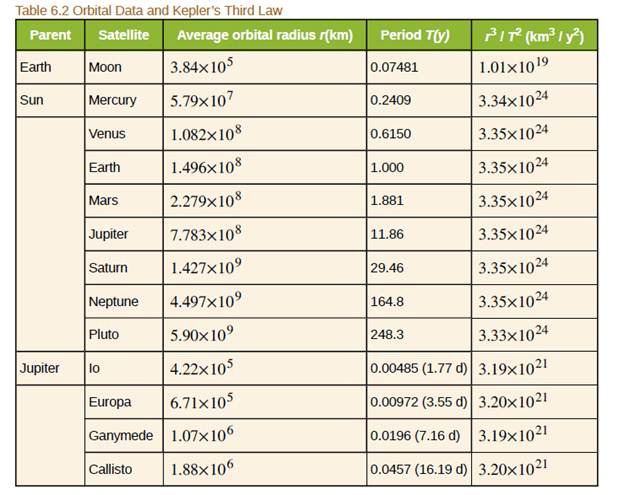
Concept explainers
A geosynchronous Earth satellite is one that has an orbital period of precisely 1 day. Such orbits are useful for communication and weather observation because the satellite remains above the same point on Earth (provided it orbits in the equatorial plane in the same direction as Earth's rotation). Calculate the radius of such an orbit based on the data for the moon in Table 6.2

Trending nowThis is a popular solution!

Chapter 6 Solutions
College Physics
Additional Science Textbook Solutions
Tutorials in Introductory Physics
Sears And Zemansky's University Physics With Modern Physics
University Physics Volume 2
Conceptual Physics (12th Edition)
Physics for Scientists and Engineers: A Strategic Approach, Vol. 1 (Chs 1-21) (4th Edition)
Physics for Scientists and Engineers: A Strategic Approach with Modern Physics (4th Edition)
- Calculate the effective gravitational field vector g at Earths surface at the poles and the equator. Take account of the difference in the equatorial (6378 km) and polar (6357 km) radius as well as the centrifugal force. How well does the result agree with the difference calculated with the result g = 9.780356[1 + 0.0052885 sin 2 0.0000059 sin2(2)]m/s2 where is the latitude?arrow_forwardSuppose the gravitational acceleration at the surface of a certain moon A of Jupiter is 2 m/s2. Moon B has twice the mass and twice the radius of moon A. What is the gravitational acceleration at its surface? Neglect the gravitational acceleration due to Jupiter, (a) 8 m/s2 (b) 4 m/s2 (c) 2 m/s2 (d) 1 m/s2 (e) 0.5 m/s2arrow_forwardWhat is the orbital radius of an Earth satellite having a period of 1.00 h? (b) What is unreasonable about this result?arrow_forward
- Let gM represent the difference in the gravitational fields produced by the Moon at the points on the Earths surface nearest to and farthest from the Moon. Find the fraction gM/g, where g is the Earths gravitational field. (This difference is responsible for the occurrence of the lunar tides on the Earth.)arrow_forwardA planet has two moons of equal mass. Moon 1 is in a circular orbit of radius r. Moon 2 is in a circular orbit of radius 2r. What is the magnitude of the gravitational force exerted by the planet on Moon 2? (a) four times as large as that on Moon 1 (b) twice as large as that on Moon 1 (c) equal to that on Moon 1 (d) half as large as that on Moon 1 (e) one-fourth as large as that on Moon 1arrow_forwardIt was stated that a satellite with negative total energy is in a bound orbit, whereas one with zero or positive total energy is in an unbounded orbit. Why zero or positive total energy is in an unbounded orbit. Why is this true? What choice for gravitational potential energy was made such that this is true?arrow_forward
- On a planet whose radius is 1.2107m , the acceleration due to gravity is 18m/s2 . What is the mass of the planet?arrow_forwardWhat is the orbital period of a satellite orbiting just above the surface of the asteroid in Problem 11?arrow_forward(a) Based on the observations, determine the total mass M of the planet. (b) Which moon and planet of our solar system is the team observing? (Use literature.)arrow_forward
- A satellite placed in a geostationary orbit will orbit with the Earth's rotation (every 24 hours), meaning that the satellite can remain directly above the same ground location. Communication and weather monitoring satellites are often placed in geostationary orbits to maintain contact with ground based towers or observation areas. What is the orbital radius of a geostationary satellite? (Give your answer in thousands of km.) Mass of Earth: 5.98x1024 kg. Note: This is over 3 times the diameter of the earth.arrow_forwardA geosynchronous orbit for a satellite is a circular orbit about the equator of the Earth in which the satellite stays fixed over a point on the equator. Use the fact that the Earth makes one revolution about its axis every 24 hours to find the altitude in miles of a communications satellite in geosynchronous orbit. Assume the Earth to be a sphere of radius 4000 mi.arrow_forwardA satellite orbits a planet in a circular orbit at an altitude (distance above the surface) of 1000km. The radius of the planet is 8000 km. The mass of the planet is 8 x 10^24 kg. What is the orbital speed? Your answer The gravitational force between a planet and its moon is óx10^16 N. For another moon orbiting the same planet with twice the orbital radius and 3 times the 5.arrow_forward
 Principles of Physics: A Calculus-Based TextPhysicsISBN:9781133104261Author:Raymond A. Serway, John W. JewettPublisher:Cengage Learning
Principles of Physics: A Calculus-Based TextPhysicsISBN:9781133104261Author:Raymond A. Serway, John W. JewettPublisher:Cengage Learning Physics for Scientists and Engineers: Foundations...PhysicsISBN:9781133939146Author:Katz, Debora M.Publisher:Cengage Learning
Physics for Scientists and Engineers: Foundations...PhysicsISBN:9781133939146Author:Katz, Debora M.Publisher:Cengage Learning University Physics Volume 1PhysicsISBN:9781938168277Author:William Moebs, Samuel J. Ling, Jeff SannyPublisher:OpenStax - Rice University
University Physics Volume 1PhysicsISBN:9781938168277Author:William Moebs, Samuel J. Ling, Jeff SannyPublisher:OpenStax - Rice University Glencoe Physics: Principles and Problems, Student...PhysicsISBN:9780078807213Author:Paul W. ZitzewitzPublisher:Glencoe/McGraw-Hill
Glencoe Physics: Principles and Problems, Student...PhysicsISBN:9780078807213Author:Paul W. ZitzewitzPublisher:Glencoe/McGraw-Hill Classical Dynamics of Particles and SystemsPhysicsISBN:9780534408961Author:Stephen T. Thornton, Jerry B. MarionPublisher:Cengage Learning
Classical Dynamics of Particles and SystemsPhysicsISBN:9780534408961Author:Stephen T. Thornton, Jerry B. MarionPublisher:Cengage Learning Physics for Scientists and Engineers, Technology ...PhysicsISBN:9781305116399Author:Raymond A. Serway, John W. JewettPublisher:Cengage Learning
Physics for Scientists and Engineers, Technology ...PhysicsISBN:9781305116399Author:Raymond A. Serway, John W. JewettPublisher:Cengage Learning





